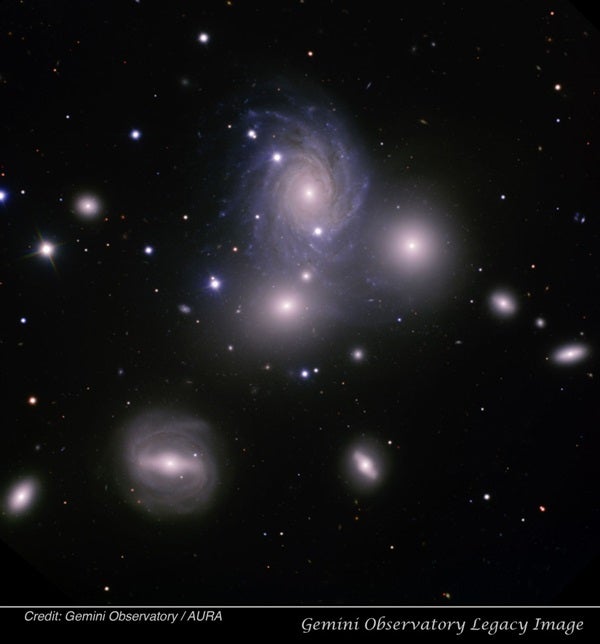Herd dynamics
Unlike animal herds, which are generally the same species traveling together, most galaxies move through space in associations composed of myriad types, shapes, and sizes. Galaxy groups differ in their richness, size, and internal structure as well as the ages of their members. Some group galaxies are composed mainly of ancient stars, while others radiate with the power and splendor of youth.
These facts raise important questions for astronomers: Do all the galaxies in a group share a common origin? Are some just chance alignments? Or do galaxy groups pick up “strays” along the way and amalgamate them into the group?
Probing galactic group interiors
The new Gemini image of a grouping called VV 166, named after its position in the catalog by B. Vorontsov-Vel’yaminov, provides clarity and definition to the group’s different morphological types despite its great distance of about 300 million light-years — some 30 times farther away than the closest galaxy groups to our Local Group. One of its most fascinating features is a perfect alignment of three disparate galaxies in a precise equilateral triangle: blue-armed spiral NGC 70 at top, elliptical galaxy NGC 68 to its lower right, and lenticular galaxy NGC 71 to its lower left.
The blue spiral (NGC 70) looks like an elephant among lions. This massive galaxy is impressive as it spans 180,000 light-years, or nearly twice the extent of the Milky Way’s reach. Its spiral arms appear blue because they are dominated by active regions of star formation. Here, hot young stars burn with an intense blue light that overpowers that from any older red and yellow stars that might populate the galaxy.
The opposite is true in the galaxy’s central bulge, where the extinction of star formation has left it to glow with the warm light of ancient red giant and supergiant suns. The galaxy’s sharp starlike core is a telltale sign of an active galactic nucleus powered by a centrally located supermassive black hole feasting on a disk of interstellar gas only a few light-days across.
In contrast, NGC 68 (lower right) is a much older system known as an elliptical galaxy. NGC 68 is about half the size of the blue spiral and hosts little dust and gas, so star formation is all but absent, as is any spiral structure; the galaxy’s overall yellowish hue reveals that most of its stars are old and red. If there’s an outlier in the image, it might be NGC 68, given that it is about 20 million light-years closer to us than NGC 70. In fact, some researchers have argued that NGC 68 is nothing but a chance alignment. Indeed, while small galaxy groups prevail in the nearby universe, many may not be real gravitationally bound systems at all. But this does not appear to be the case with VV 166, for most of these galaxies are indeed bound as a group.
Although NGC 71 looks much like NGC 68 — a smooth featureless glow, below and to the left of NGC 68 — it is actually a lens-shaped galaxy seen face on, so it appears more like a sphere. Lenticular galaxies are mysterious creatures, as they appear to be trapped between classifications: like a spiral galaxy, it has a bulge and a disk but no spiral arms; like an elliptical galaxy, it is largely devoid of dust and gas. Possibly galaxies like NGC 71 were originally spiral systems and have either consumed or somehow lost their interstellar material through other galactic interactions.
The image also shows possible evidence for such a dynamic interaction. Careful inspection reveals that blue spiral’s arms appear distorted between NGC 68 and NGC 71, indicating a possible tidal interaction with one or more of the galaxies. These graceful interactions are choreographed as the group whizzes collectively through space at about 4,000 miles (6,500 kilometers) per second. The image also sharply resolves a flurry of starlight around the elliptical and lenticular systems. Often the brightest cluster galaxy has an extraordinarily diffuse and extended outer halo.
Just beyond the triangle to the lower left is the group’s fourth-brightest member, a barred spiral galaxy known as NGC 72. Its prominent bar slices across its nucleus. Dusty arms wind out from either end of the bar and form a distinct nuclear ring — the result of recent star formation. Our Milky Way Galaxy has a similar bar component spanning nearly 30,000 light-years from end to end, as well as a circumnuclear ring. But we have evidence that our Milky Way is a “grand-design” spiral with more splendid and numerous arms.
Despite the apparent diversity of galaxy types in VV 166, the relative proportions of morphologies that we see here may provide a representative sample of galactic types found throughout the universe. It’s possible that some members of VV 166 may have grown by drawing in smaller galaxies from the local environment and consuming them. Or, perhaps, like some herds of animals, galaxy groups may be joined by other “species” — sometimes passively, sometimes violently; this would help to explain the observed mix of morphological types in these groups.
On the larger cosmological scale, galaxy groups are like beads in the long filamentary structures that make up the skeleton of our universe. These filaments are made up of isolated galaxies, groups, clusters, and superclusters. In time, the isolated galaxies may merge with the groups, which will themselves merge with other groups to form larger clusters of galaxies. As with the animal kingdom, the universe has its hierarchy and includes all things great, and even greater.










